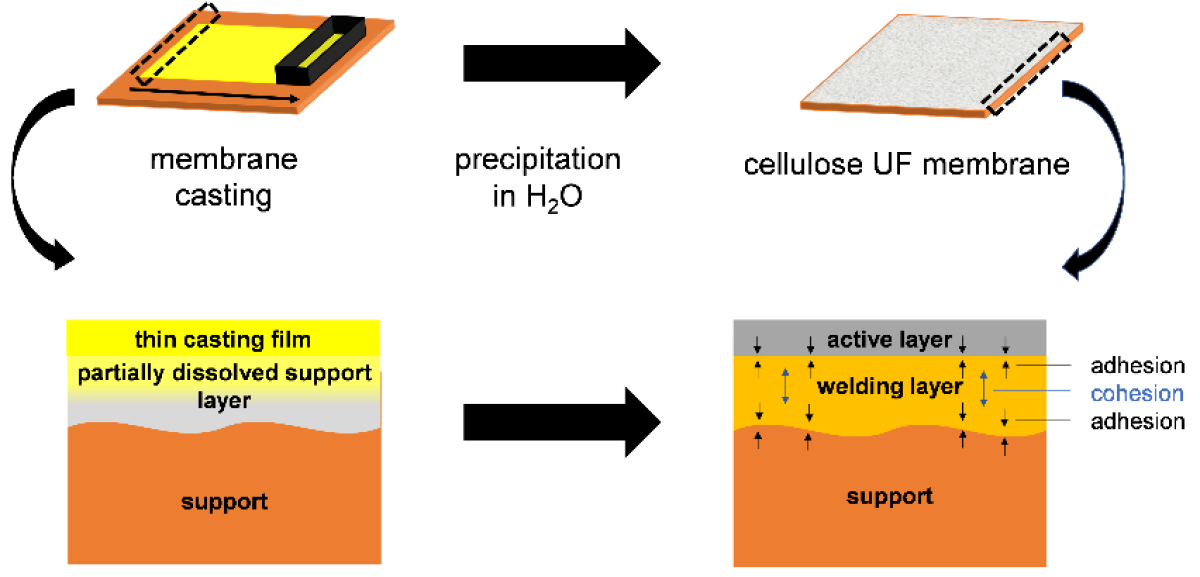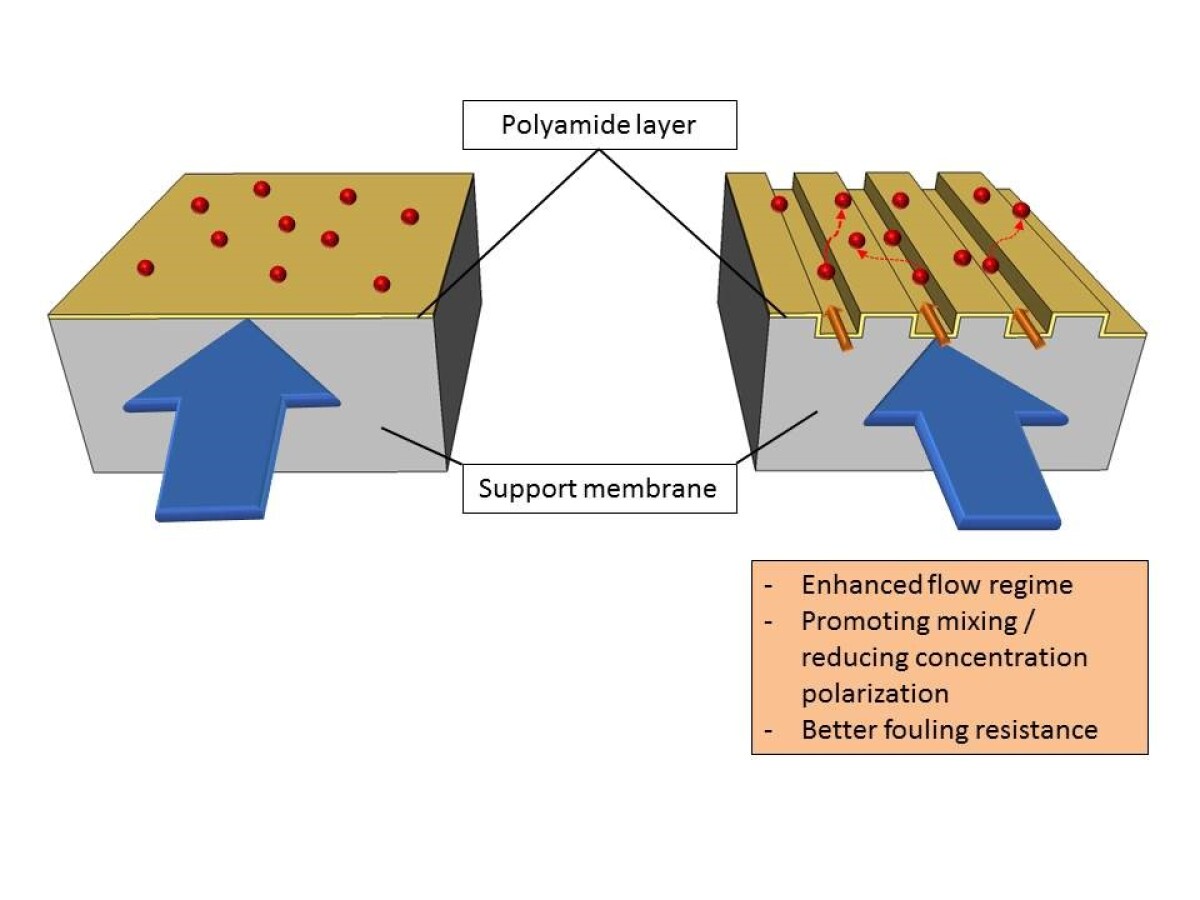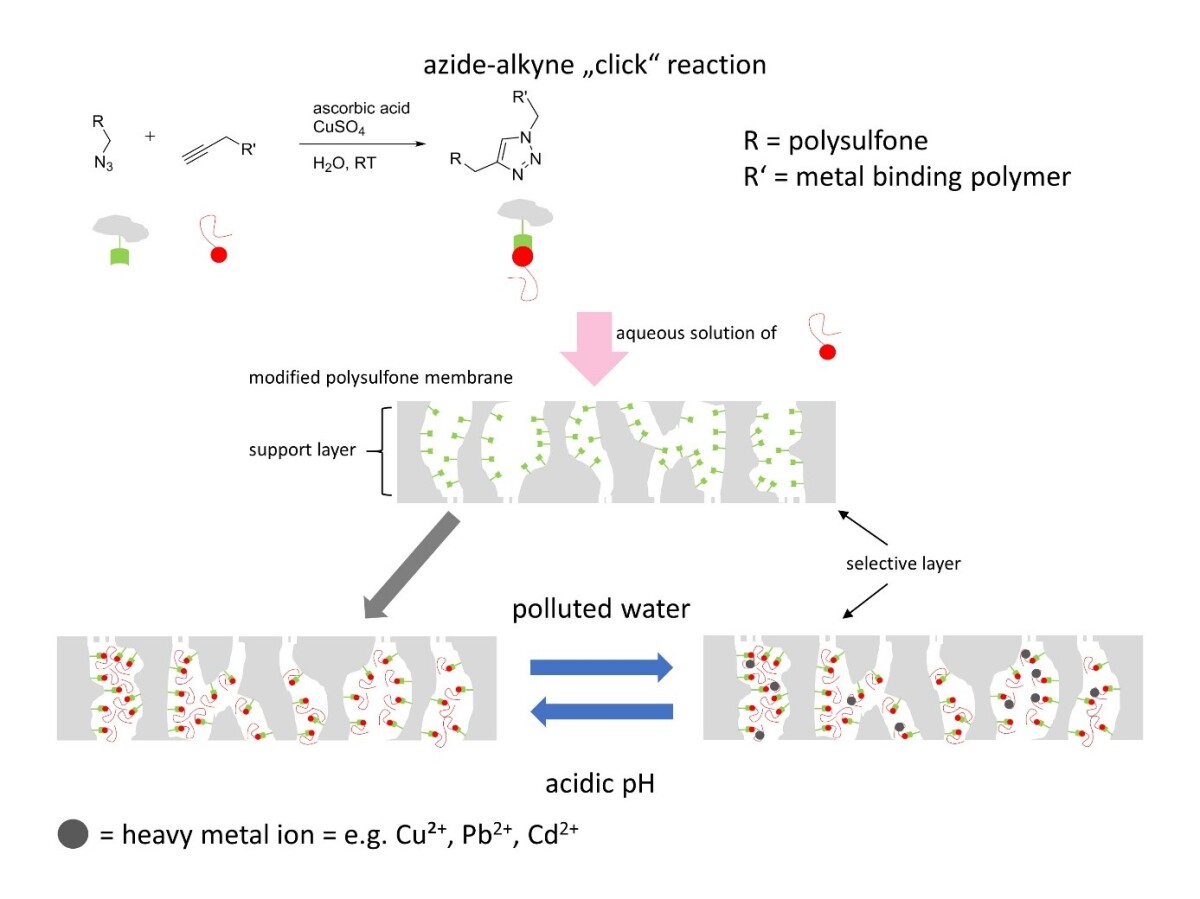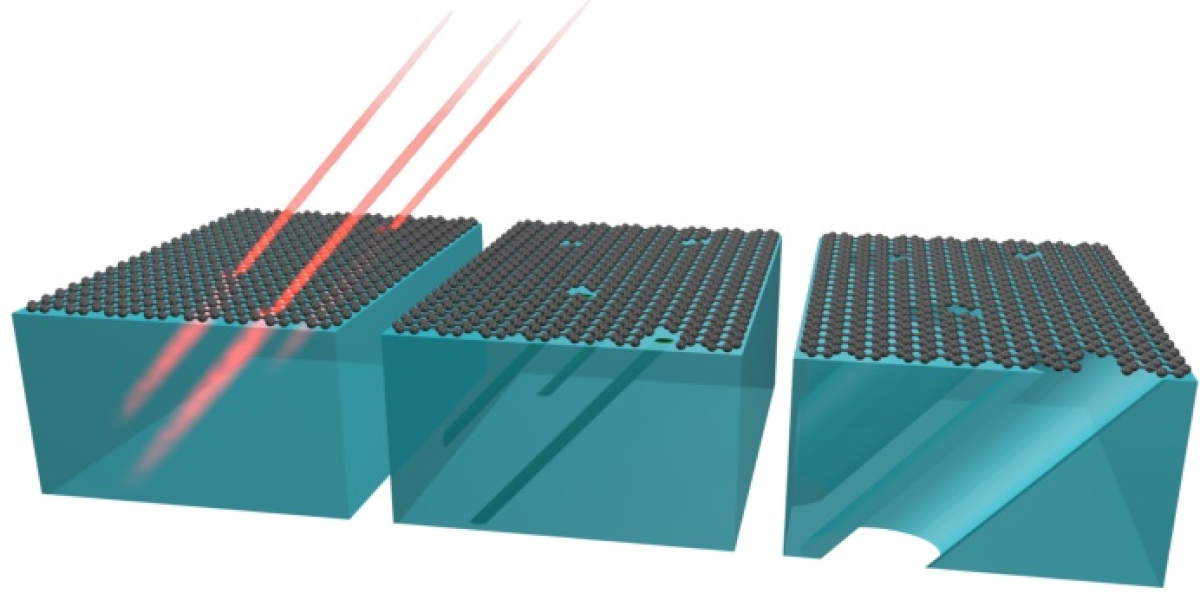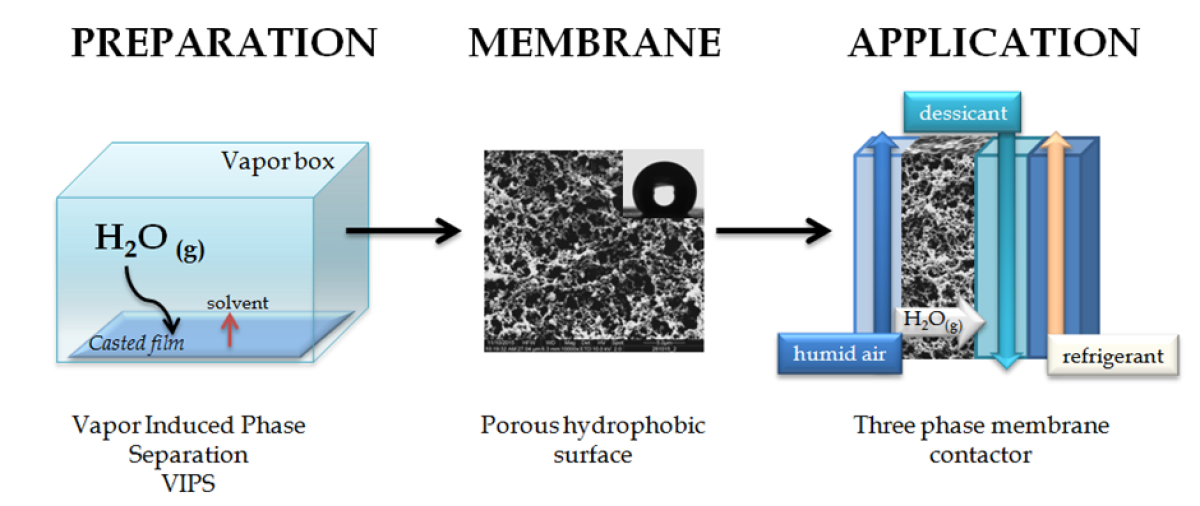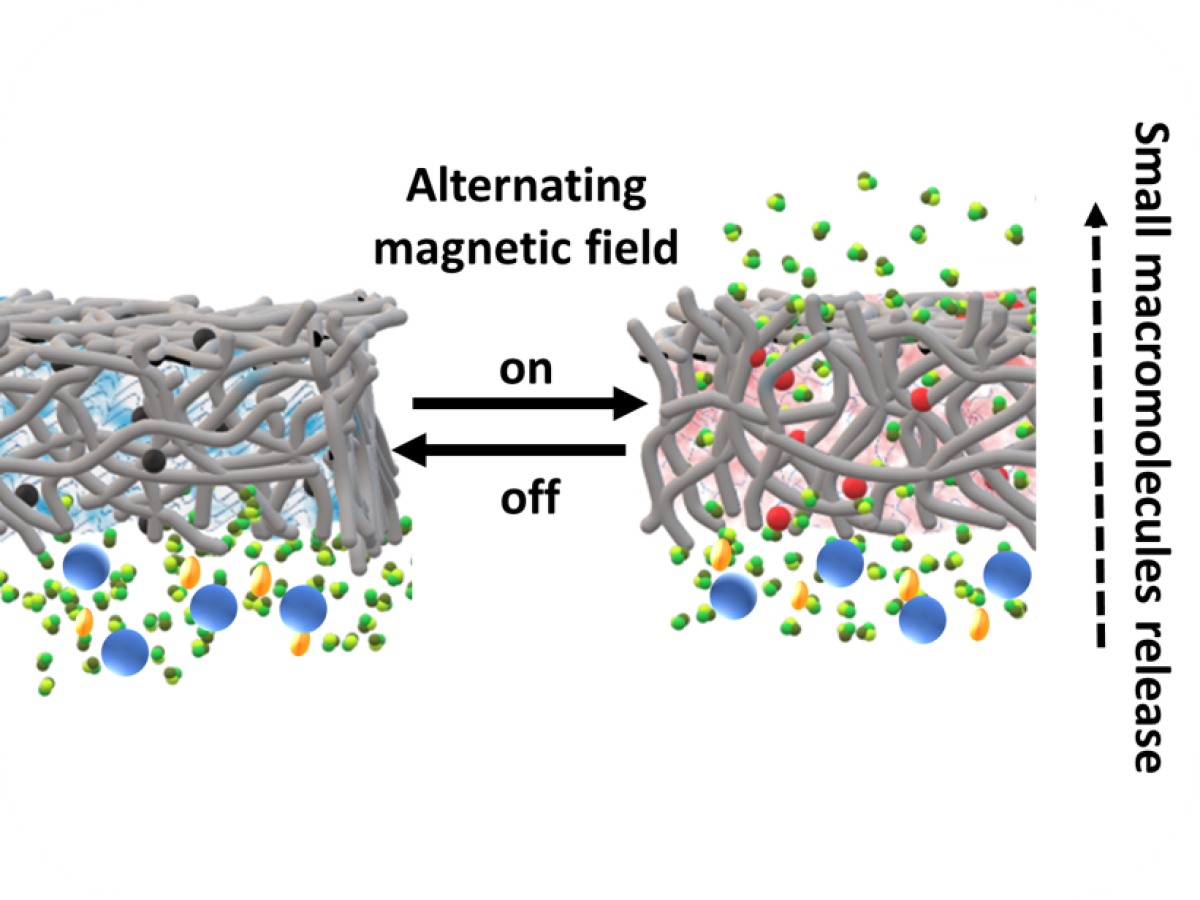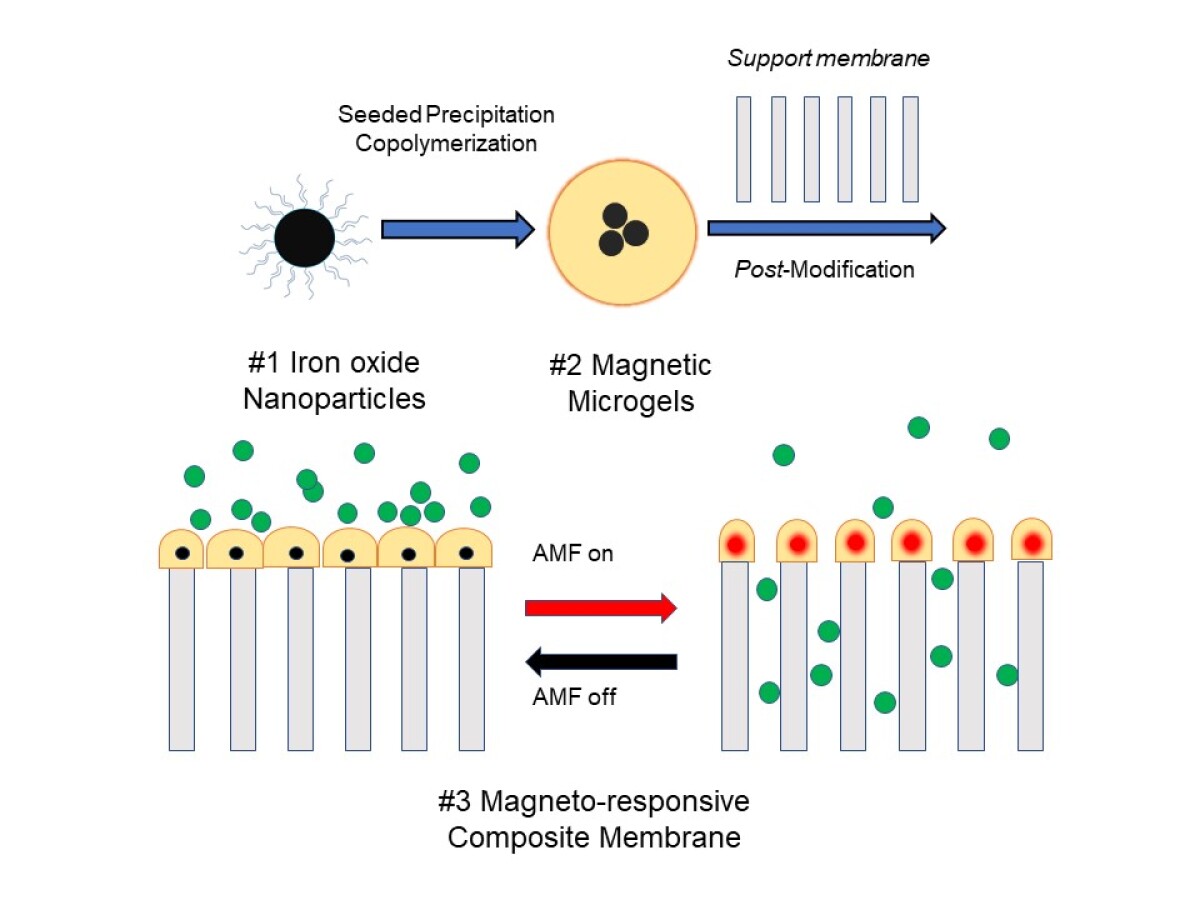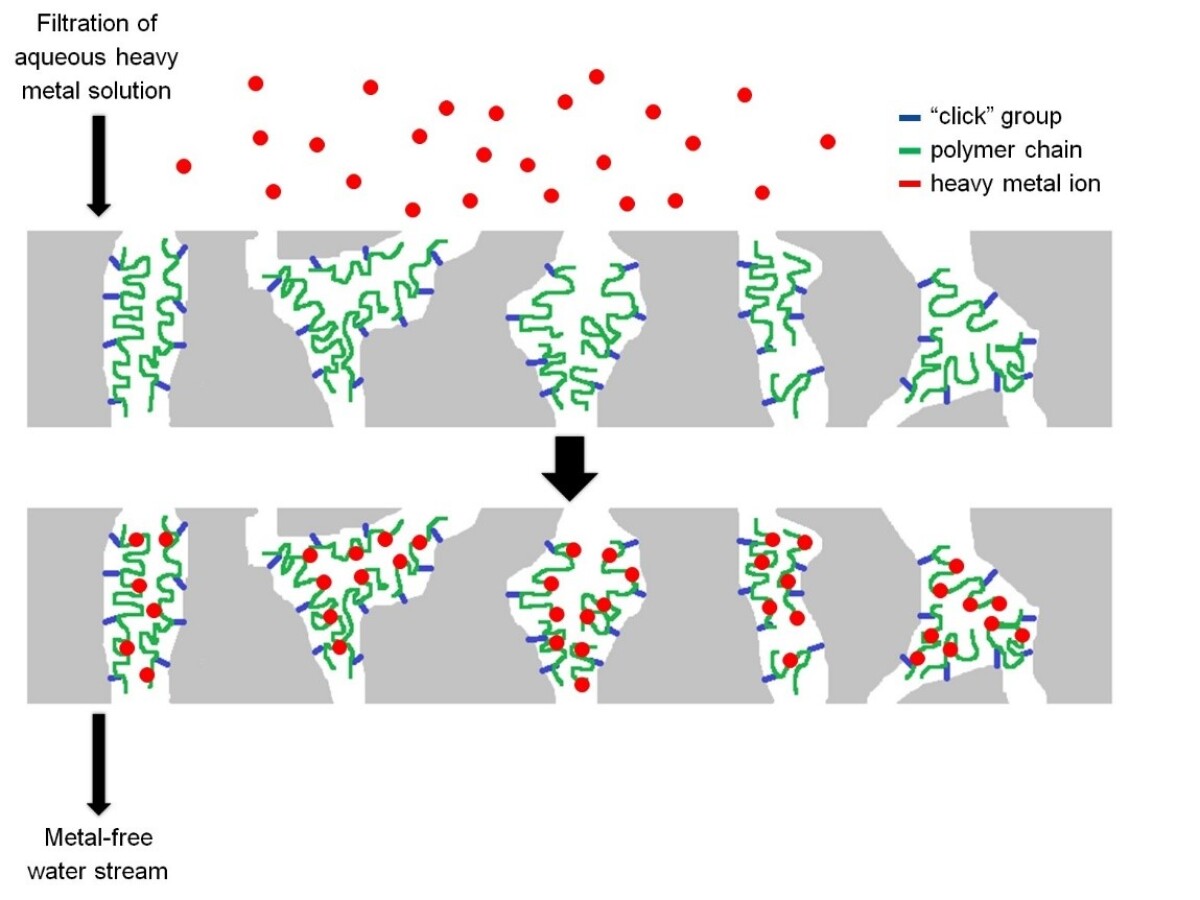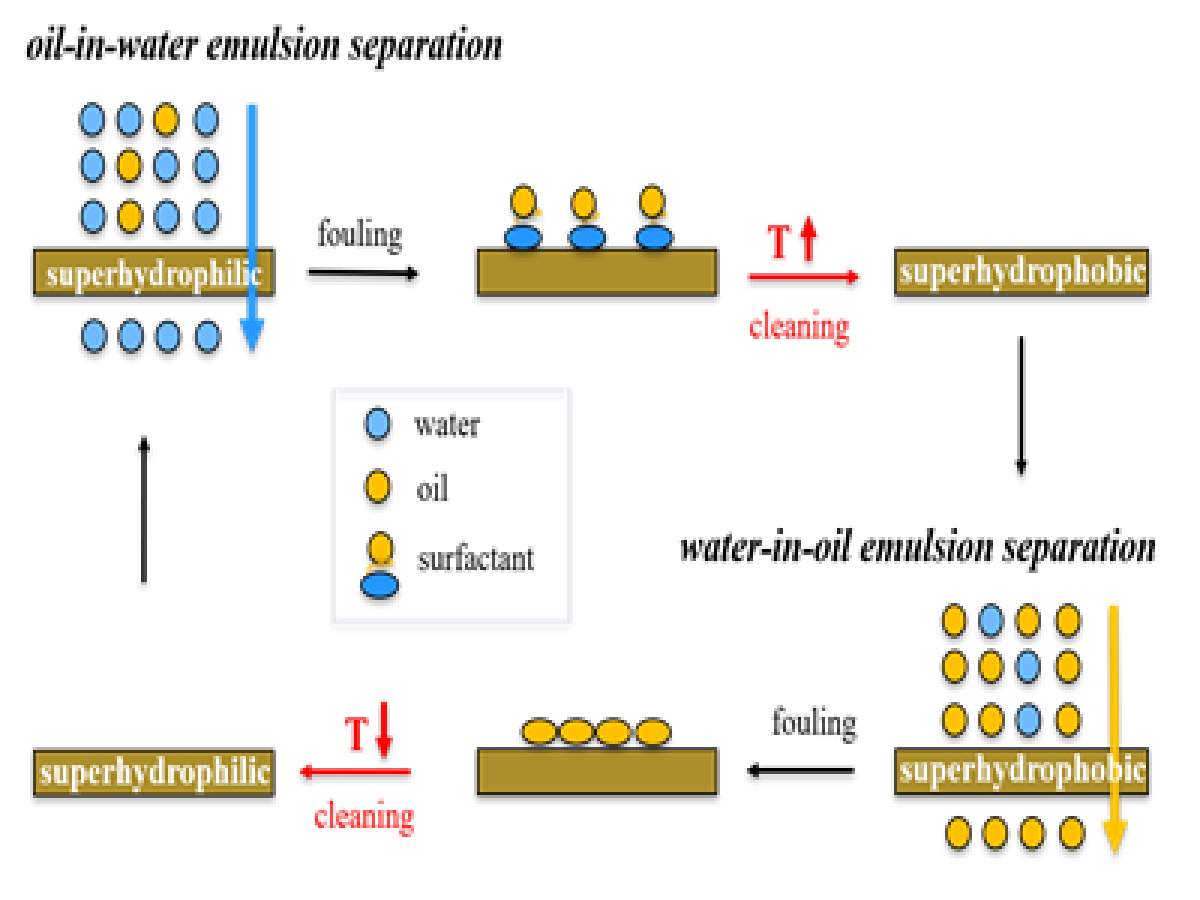Separation membranes: preparation
Content
- Cellulose-Cellulose Composite Membranes for Ultrafiltration
- Fabrication and Evaluation of Patterned Thin Film Composite Membranes
- Functionalizing ultrafiltration membranes to achieve adsorber properties
- Graphene/Poly(ethylene terephthalate) Composite Membranes for Ultrafiltration
- INNOMEM: Roll-to-Roll Casting of Advanced Nanophase-Segregated Ion-Exchange Polymer Membranes
- Macroporous hydrophobic flat-sheet PVDF membranes via vapor induced phase separation
- Magneto-responsive nanohybrid membranes for controlled release of proteins
- Magneto-responsive composite membrane with magnetic microgels as smart gates
- Micro- and nanostructured thin film composite membranes for desalination
- Reactive and functional copolymers as building blocks for separation membranes
- Responsive Antifouling Property of PVDF Membrane in Oil Water Emulsion Separation
Cellulose-Cellulose Composite Membranes for Ultrafiltration
Due to the increasing water demand, especially in rural areas, instant water purification with bio-based disposable filters, e.g. made from cellulose has become a relevant research topic. The precondition for membrane preparation by phase inversion is the cellulose dissolution in a suitable solvent. Ionic liquids, a new class of solvents, can be used to dissolve cellulose under very mild and, thus, also eco-friendly conditions.[1] The aim of this work is establishing a novel fabrication method of completely renewable and biodegradable cellulose-cellulose composite membranes for ultrafiltration (UF) by film casting of a solution of cellulose in ionic liquids and subsequent phase inversion on filter paper as support.
The formation of the composite membrane occurs in two steps. During the film casting the support is partially dissolved. After the phase inversion, the active layer is formed and welded to the support, resulting in stable lamination between the two cellulose layers. The feasibility of producing cellulose-cellulose composite membranes with that method was demonstrated; membranes with UF performances could be achieved.[2] The addition of a co‑solvent like DMSO improves the cellulose solubility in the ionic liquid and decreases the casting solution viscosity.[3] The separation performance of the prepared membranes can be specifically adjusted by parameters such as cellulose concentration and co-solvent content.2 However, the support can also be penetrated by the casting solution during the film casting leading to too low permeability. The separation performance was improved by a pre-wetting step of the support to prevent pore penetration, but it also has weakened the membrane lamination as shown by adhesion tests. Ongoing studies are focussed on the relationships between support structures as well as film casting and phase separation conditions on the one hand, and composite membrane structure and UF separation performance on the other hand.
References:
[1] R. P. Swatloski, S. K. Spear, J. D. Holbrey, R. D. Rogers, Journal of the American Chemical Society, 2002, 124, 4974–4975.
[2] D. H. Tran, M. Ulbricht, Chemie Ingenieur Technik, 2019, 91, 1123–1128.
[3] A. Wittmar, M. Ulbricht, Industrial & Engineering Chemistry Research, 2017, 56, 2967–2975.
Contact: Duc Hoa Tran, M.Sc.
Fabrication and Evaluation of Patterned Thin Film Composite Membranes
Several studies have shown that the patterning of thin-film composite (TFC) membranes surface has improved membranes performance in regards of increasing permeance and reducing concentration polarization and fouling [1,2]. Those studies fabricated patterned TFC membrane using either nano- or micro-imprinting lithography followed by interfacial polymerization reaction (IP), or by direct imprinting of commercial TFC membranes with nanoscale pattern [1-3]. The aims of this study are to fill the knowledge gaps regarding scope and mechanisms of micro-imprinting lithography and its combination with IP and to investigate the potential of direct patterning TFC membranes with microscale pattern.
The preliminary results with prototype membranes indicate that there is no significant change of permeance after micro-imprinting for both porous support and TFC membranes. Optical and scanning electron microscopy observations confirm that the pattern has been successfully imprinted without observable defect. To understand the underlying mechanism of both methods and to determine whether the imprinting processes are suited for any specific membrane type, series of various microscopy and spectroscopy analyses will be done. On practical side, the performance of the patterned membranes, especially in regards of permeance, solute rejection as well as concentration polarization mitigation and its relation to the flow orientation relative to the pattern (perpendicular, parallel, etc.), will be thoroughly investigated. The evaluation of fouling mitigation by surface pattering in combination with cross-flow conditions is another important topic.
References:
[1] I.M.A ElSherbiny, A.S.G. Khalil, M. Ulbricht, Journal of Membrane Science, 2017, 529, 11-22.
[2] I.M.A ElSherbiny, A.S.G. Khalil, M. Ulbricht, Membrane, 2019, 9, 67.
[3] O. Heinz, M. Aghajani, A.R. Greenberg, Y. Ding, Current Opinion in Chemical Engineering, 2018, 20, 1-12.
Funding: This project is funded by the DAAD (Deutsche Akademische Austauschdienst)
Contact: Eliezer J. Kurnia, M.Sc.
Functionalizing ultrafiltration membranes to achieve adsorber properties
Water contaminations with toxic heavy metals are a dominant environmental problem generated through industrial processes. Membrane processes have aroused a high interest in the last years for wastewater treatment but can, in case of ultrafiltration (UF), only be used for removal of particles and colloids. Adsorption integrated into filtration membranes could serve as an option to deal with these problems.[1] For this purpose, polysulfone (PSU) as base membrane material is functionalized to allow a “click” reaction with functional polymers capable of binding metal ions.[2] “Clickable” metal-binding polymers are obtained by functionalization of commercially available polymers like polyethyleneimine (PEI) or polyacrylic acid (PAA).
Polysulfone was chloromethylated to different degrees and subsequently converted to azide-containing membrane polymer. Membranes were cast from these polymers and characterized in terms of pore structure and UF performances. PEI with different molar masses were modified to contain alkyne groups at differing degrees of substitution. As alternative, PAA was transformed into an acrylamide copolymer by reacting carboxylic acid groups with different functional amines to introduce desired side groups. A heterogeneous “click” reaction was performed via infiltration of an aqueous solution containing functional polymer into the support layer of the UF membranes. The adsorption capacity for Cu2+ of coated membranes in a static adsorption experiment was shown to be higher than for not functionalized membranes and to correlate with fraction of azide groups available for “click” reaction in the membrane. In dynamic adsorption, during filtration, a maximum loading of 30 mg/g was reached. The study shows possibilities in terms of preparing membrane adsorbers with “click” chemistry.
References:
[1] F. Farjadian, S. Schwark, M. Ulbricht, Polymer Chemistry, 2015, 6, 1584–1593.
[2] Y. Xie, R. Tayouo, S. P. Nunes, Journal of Applied Polymer Science, 2015, 132, 41549.
Funding: This work is part of the project POLINOM (grant number 03XP0106C), supported by the German Ministry of Education and Research (BMBF) as part of the “Materialien für eine nachhaltige Wasserwirtschaft – MachWAS” initiative.
Contact: Dereck Koch, M.Sc.
Graphene/Poly(ethylene terephthalate) Composite Membranes for Ultrafiltration
Membranes with specific barrier structures can be used in a wide range of applications, for, e.g., ultrafiltration, dialysis, or gas separation [1]. For all these applications the selective barrier should be as thin and robust as possible. Because of its infinitesimal thickness of 3 Å, great mechanical strength, impermeability for gases and liquids, and chemical inertness, the quasi 2D material graphene seems to be the ideal material for a selective barrier [2]. With porous graphene, because of negligible wall interactions, one could achieve very high transport rates (permeabilities) in filtering applications.
The aim of this work is to produce an ultrafiltration membrane which consists of a selective barrier of perforated monolayer graphene on top of a porous polymer support and to demonstrate its superior performance. Several approaches had been made to produce a perforated graphene membrane, for instance by focused electron beam ablation, ultraviolet-induced oxidative etching, or oxygen plasma etching [3]. Because all these techniques have intrinsic problems [3], another approach is used in this project. First, large area CVD graphene is transferred from copper foil onto a polymer film (polyethylene terephthalate, PET). This composite is irradiated by swift heavy ions (SHI, 6-1500 MeV), which perforate the whole composite. Due to its high energy the SHI form atomic pores directly in the graphene. In the polymer support a latent ion track is formed. After irradiation the composite is treated with NaOH solution to form pores in the polymer out of the latent ion tracks while graphene is inert on the etchant. The pore diameter in the graphene layer depends on the irradiation conditions and is in the range from 2 to 10 nm; each pore is aligned with a larger one in the PET support. Potential applications of those composite membranes are special separation problems like protein fractionation.
The work is done in close collaboration with physicist, and main current tasks of the group are developing suited composite preparation protocols, reducing the defect density in the graphene layer and characterizing the barrier properties of the resulting composite membranes [4].
References
[1] M. Ulbricht, Polymer 2006, 47, 2217
[2] P. Sun, K. Wang, H. Zhu, Advanced Materials, 2016, 28, 2287
[3] L. Huang, M. Zhang, C. Li, G. Shi, Journal of Physical Chemistry Letters, 2015, 6, 2806
[4] L. Madauß, J. Schumacher, M. Ghosh, O. Ochedowski, J. Meyer, H. Lebius, B. Ban-d'Etat, M. E. Toimil-Molares, C. Trautmann, R. G. H. Lammertink, M. Ulbricht, M. Schleberger, Nanoscale, 2017, 9, 10487
Funding: The work is part of a collaborative project (NU-TEGRAM) within the FLAG-ERA JTC 2015 program of the European Union, and it receives funding from the German Research Council (DFG, Ul 113/10-1).
Contact: Jens Schumacher, M.Sc.
INNOMEM: Roll-to-Roll Casting of Advanced Nanophase-Segregated Ion-Exchange Polymer Membranes
In recent years, the idea of a green hydrogen economy has been revived. Possibilities lie in the reduction of carbon emissions in industry processes like ammonia synthesis or steel refining or the storage of the periodic excess energy from renewable resources like solar or wind. A promising method for green hydrogen synthesis is the anion-exchange membrane (AEM) water electrolysis, combining cheap materials and high efficiency. At the moment, the bottleneck for this method is the limited performance of available membranes.[1] The aim of this work is to develop AEMs with optimized properties and to transfer the manufacturing process to a roll-to-roll coating / membrane casting pilot line.[2]
The formation of the membranes is done via solution casting and drying of the polymer film to yield dense and isotropic flat sheet membranes. During this process, nanophase-segregation between hydrophobic backbone and charged side chains can occur. The resulting nanoregions can function as transport channels for ions and water and can improve ionic conductivity. To better understand the underlying mechanism of nanophase-segregation and its influence on conductivity, the process parameters for membrane formation are investigated and optimized. Through the analysis of material and electrochemical properties the performance of membranes is quantified. Overall, the focus lies on transferring the membrane fabrication to a roll-to-roll pilot line with focus on maximizing production rate and batch-to-batch reproducibility. Therefore, a main part of this project consists of the assessment and upgrading of the existing setup to establish a pilot line configuration for up-scaling the casting of ion-exchange membranes.
References:
[1] H. A. Miller, K. Bouzek, J. Hnat, S. Loos, C. I. Bernäcker, T. Weißgärber, L. Röntzsch, J. Meier‑Haack, Sustainable Energy & Fuels, 2020, 4, 2114-2133.
[2] C. Alexowsky, M. Bojarska, M. Ulbricht, Journal of Membrane Science, 2019, 577, 69-78.
Funding: INNOMEM receives funding from the European Union's Horizon 2020 Research and Innovation Program under Grant Agreement N° 862330.
Contact: Dr. Lukas Fischer
Macroporous hydrophobic flat-sheet PVDF membranes via vapor induced phase separation
In gas/liquid membrane contactors with aqueous solutions, porous hydrophobic membranes are required. Typically polypropylene, polyvinylidene fluoride (PVDF) or polytetrafluoroethylene (PTFE) are used. For many emerging applications, contactor membranes should be similar to those already used in membrane distillation. Such membranes should be highly porous and as thin as possible to enhance vapor transport, exhibit low heat conductivity to minimize heat loss, be hydrophobic and have proper pore size for anti-wetting properties [1]. Generally, PTFE membranes show higher hydrophobicity than PVDF membranes. However, considering the difficulty involved in processing PTFE, PVDF is the most promising membrane polymer for scale-up [1].
Vapor Induced Phase Separation (VIPS) is a promising method for obtaining highly porous membranes. In VIPS, phase separation is induced by the dilution of the solvent in the polymer solution with the non-solvent (typically water) taken up from the vapor phase. Factors like relative humidity, exposure time to humid air or airflow velocity influencing mass transfer can be used for tuning VIPS conditions, so that macroporous membranes with high porosity, isotropic cross section and narrow barrier pore size distribution can be achieved. Also polymer concentration and dissolution temperature influence membrane morphology and structure. Using these parameters, PVDF membranes with barrier properties tailored for application in a new three-phase membrane contactor are developed.
References
[1] H. Fan, Y. Peng, Z. Li, et al., Journal of Polymer Research, 2013, 20, 134
| Funding: This work is supported by the EU Horizon 2020 project “XERIC – Innovative Climate-Control System to Extend Range of Electric Vehicles and Improve Comfort” (www.xeric.eu) | 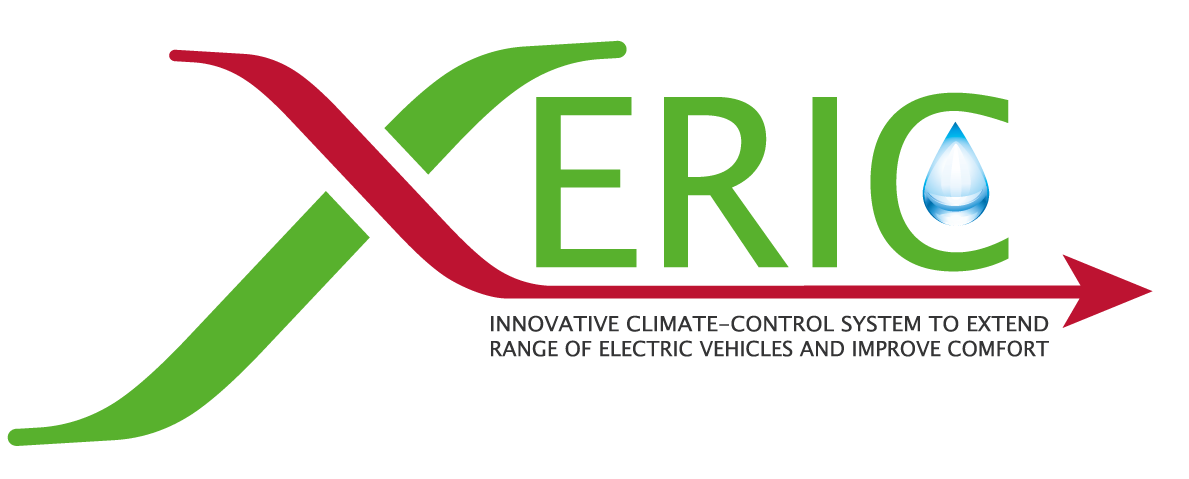 |
Contact: Prof. Dr. Mathias Ulbricht
Magneto-responsive nanohybrid membranes for controlled release of proteins
Albeit the challenges facing delivery of protein therapeutics, there is a trending FDA approval of new molecules during the last decade. Responsive membranes can offer a reliable solution with high reproducibility and dosing flexibility. Former work in our research group included membrane pore-filling with thermo-responsive hydrogel that contains magnetic nanoparticles that demonstrated excellent switchable rejection for dextran 2000 kDa [1]. This project aims at developing membranes with switchable rejection for smaller macromolecules while maximizing the magnitude of release.
Accordingly, thermo-responsive pore-filled membranes are developed through a two-steps approach that facilitates scaling-up of the process. Polyethersulfone creates base membranes (BM) which are subsequently filled with poly(N-isopropylacrylamide) hydrogel -that acts as the sieving medium- using in situ UV-induced cross-linking polymerization. In response to heating above the hydrogel volume phase transition temperature, membranes showed a 21-fold increase in diffusion rate of dextran (4 kDa, which has a comparable Stokes diameter to that of insulin). This opens up the possibility for pulsatile biomacromolecules release. As an example, a membrane with a radius of 2 cm (12.6 cm2) could deliver the average insulin daily requirement in 2 hours of stimulation. Performance could be further enhanced through investigating the effects of BM porosity, thickness and hydrogel content, as well as, factors affecting the hydrogel responsivity. Furthermore, magnetic nanoparticles generate heat through hysteresis and Neel relaxation losses when subjected to an external alternating magnetic field. Thus, the incorporation of magnetic nanoparticles in the BM prior to the hydrogel pore-filling will permit a spatial thermal control. Such a magneto-responsive membrane can act as a gate to a system for an on-demand remotely controlled release of biomacromolecules.
References:
[1] X. Lin, R. Huang, M. Ulbricht, J. Mater. Chem. B, 2016, 4, 867-879
Funding: This project is funded by the DAAD (Deutscher Akademischer Austauschdienst) through the GERLS program.
Contact: Mohamed Elleithy, M.Sc.
Magneto-responsive composite membrane with magnetic microgels as smart gates
Stimuli-responsive membranes have attracted attention as they can self-regulate their permeability and selectivity properties in response to a specific stimulus such as pH, ions or temperature. Those smart membranes featuring dynamic properties have the potential to be utilized in advanced applications. However, to modify membrane’s intrinsic barrier properties, it is common to induce a response by changing conditions of the feed stream; this can make the utilization of such membranes inflexible, inefficient or even impossible. To solve this issue, this project focuses on the design of magneto-responsive ultrafiltration membranes featuring temporal and remote-controlled molecular sieving [1,2].
Our current approach is the design of thin layer composite membranes with magnetic microgels (MM) as smart gates. Triggered by a high frequency alternating magnetic field, iron oxide nanoparticles (IONP) generate heat, which evokes a reversible phase transition in the thermo-responsive polymer poly(N-isopropyl acrylamide) (PNIPAAm). This transition is observed by deswelling of the microgel, which shall cause a shift of the molecular weight cut-off. We expect that a direct contact of the local heater with the target actuator by a core-shell structure maximizes the synergistic effect as well as simplifying membrane modification. To prepare MMs, IONP were synthesized by the co-precipitation method and afterwards encapsulated with cross-linked PNIPAAm by seeded precipitation copolymerization [3]. The prepared MMs were easily purified by magnetic separation and had a narrow particle size distribution. Finally, pre-functionalized support membranes were surface modified with MMs by particle filtration. Water filtration at different temperature proved reversible and stable thermo-responsive properties of the composite membranes. Currently, the modified membranes are studied regarding ultrafiltration selectivity and magneto-responsive behavior. Further parameter studies are carried out to tune the separation performance of the novel magneto-responsive composite membranes.
References:
[1] X. Lin, R. Huang, M. Ulbricht, Journal of Materials Chemistry B, 2016, 4, 867.
[2] X. Lin, B. Nguyen Quoc, M. Ulbricht, ACS Applied Materials and Interfaces, 2016, 8, 29001.
[3] A. Rauh, T. Honold, M. Karg, Colloid and Polymer Science, 2016, 294, 37.
Contact: Sanae Gassa, M.Sc.
Micro- and nanostructured thin film composite membranes for desalination
Polyamide (PA) thin-film composite (TFC) membranes are the most prevalently used materials for pressure-driven water desalination. Recently, a number of theoretical and experimental studies have introduced topographic surface patterning as an interesting alternative to yield efficacious membranes possessing enhanced fouling resistance [1]. The patterned TFC membranes were found to exhibit higher water flux and lower tendency towards scaling, however these submicron-patterned membranes suffered from modest NaCl rejection behavior, ≤ 90% [2]. Achieving high monovalent salt rejection for these patterned membranes is still considered as a challenge.
This project aims to introduce more reliable and detailed fabrication guide towards high performance micro-structured PA TFC membranes exhibiting enhanced antifouling resistance. Two different surface micropattering methods are implemented, combined process of vapor- and non-solvent induced phase separation micromolding (PSµM) as well as nanoimprinting lithography (NIL). Novel macroporous supports of isotropic pore size distribution and average barrier pore diameter of 100 nm, developed in our group [3], are employed as supports for the new micro-structured membranes. A number of parameters were investigated for PSµM, including the range of pattern, suitable pretreatment procedure for the mold, and exposure time to humid air. Suited NIL conditions were also identified. The fidelity of the micro-patterning methods was studied comprehensively, and details for different surface pattering mechanisms are proposed. Polyamide layer synthesis was then adapted to the developed micro-structured supports and the impact on membrane performance due to difference in micro-patterning resolution was explored [4]. Moreover, the surface of the novel patterned TFC membranes will be further modified using different surface modification techniques to evaluate the change in resistance of desalination membrane towards scaling and biomolecules attachment as a result of expected synergism between surface micro-pattering approach and stimuli responsive behavior.[5]
References:
[1] Y.K. Lee, Y.J. Won, J.H. Yoo, K.H. Ahn, C.H. Lee, J. Membr. Sci., 2013, 427, 320
[2] S.H. Maruf, A.R. Greenberg, Y. Ding, J. Membr. Sci., 2016, 512, 50
[3] I.M.A. ElSherbiny, R. Ghannam, A.S.G. Khalil, M. Ulbricht, J. Membr. Sci., 2015, 493, 782
[4] I. M. A. El-Sherbiny, A. S. G. Khalil, M. Ulbricht, J. Membr. Sci., 2017, 529, 11-22
[5] I. M. A. El-Sherbiny, A. S. G. Khalil, M. Ulbricht, Tailoring Surface Characteristics of Polyamide Thin-Film Composite Membranes towards Pronounced Switchable Wettability, Advanced Materials Interfaces, 2018, accepted
| Funding: This work was part of “SURSYS” project funded by German Academic Exchange Service (DAAD) and financed by the Federal Foreign Office of Germany (2013 – 2015). |
Contact: Prof. Dr. Mathias Ulbricht
Reactive and functional copolymers as building blocks for separation membranes
Nowadays treatment of (waste)water becomes more and more important due to increasing concentration of pollutants. Especially water contamination with heavy metals is one of the biggest problems society is facing. Several industries such as metal finishing, batteries manufacturing and others generate these heavy metal pollutants in water. Due to their toxicity they must be removed which is done by filtration, adsorption or selective precipitation.[1] Membrane processes have gained a high interest in the last years for (waste)water treatment. The aim of this work is to combine adsorber materials and filter membranes resulting in a promising option for more efficient removal of heavy metals.
Therefore, this project deals with the synthesis and modification of functional copolymers. They serve as building blocks to yield adsorbers for targeted heavy metal ions (especially Pb2+ and Cu2+). The first investigated examples of heavy metal complexing are 8‑hydroxyquinoline derivatives. Moreover, the copolymer should enable its covalent binding to the membrane, which is done via “click” reaction between alkyne groups (in the polymer) and azide groups (on the membrane surface). Furthermore, the copolymer should be water soluble, yielding an expanded conformation for the surface-bound macromolecules. This property simplifies the reactive coating process because no other solvent is needed, and dissolved heavy metal ions can be complexed during filtration of contaminated water. Various routes toward such multifunctional copolymers with targeted combinations of properties are explored. The functionalized membranes are characterized in terms of their filtration performance, the static and dynamic adsorption capacities for the heavy metal ions, the efficiency of regeneration and, hence, the application potential of the novel membrane adsorbers.
References:
[1] H. A. Qdais, H. Moussa, Removal of heavy metals from wastewater by membrane processes: a comparative study, Desalination, 2004, 164, 105–110.
Funding: This work is part of the project POLINOM (grant number 03XP0106C), supported by the German Ministry of Education and Research (BMBF) as part of the “Materialien für eine nachhaltige Wasserwirtschaft – MachWAS
Contact: Sebastian Buchholz, M.Sc.
Responsive Antifouling Property of PVDF Membrane in Oil Water Emulsion Separation
Due to the significance of wettability in the oil water emulsions separation, the two types of membranes with either superhydrophilicity or superhydrophobicity could be utilized in oil-in-water and water-in-oil emulsion separation, respectively [1]. Hydrophobic membranes are prone to be fouled by oil, while hydrophilic membranes may become less hydrophilic and more oleophilic upon adsorption of surfactants, ultimately also resulting in fouling. Therefore, a thermally responsive porous membrane that switches between superhydrophilicity and superhydrophobicity is an attractive strategy for advanced anti-fouling property, and such membrane could be applied in efficient separation of both oil-in-water and water-in-oil emulsions.
Artificial surfaces with superhydrophilicity or superhydrophobicity are commonly fabricated via two kinds of approaches: i) introducing surface micro-/nanostructures on chemically hydrophilic or hydrophobic substrates; ii) chemical modification of micro-/nano-patterned surfaces using materials of high or low surface free energy. In this work polyvinylidenefluoride (PVDF) is used as membrane material. The thermally responsive PVDF membrane that switches between superhydrophilicity and superhydrophobicity shall be obtained via introducing poly(N-isopropylacrylamide) (PNIPAAm) [2], a typical example of a thermally responsive polymer that has a lower critical solution temperature (LCST) of about 32–33 °C, into the rough membrane surface. PVDF membrane with micro/nano-structured roughness is prepared by immersion precipitation phase inversion, for example with water as additive to the casting solution. Subsequently, PNIPAAm is incorporated into the surface of PVDF membrane via dopamine co-deposition.
References:
[1] Cai, Y., Chen, D., Li, N., Xu, Q., Li, H., He, J., & Lu, J., A smart membrane with antifouling capability and switchable oil wettability for high-efficiency oil/water emulsions separation, Journal of Membrane Science, 2018, 555, 69-77.
[2] Yang, Q., Adrus, N., Tomicki, F., & Ulbricht, M., Composites of functional polymeric hydrogels and porous membranes, Journal of Materials Chemistry, 2011, 21, 2783-2811.
Funding: We gratefully acknowledge the support provided by China Scholarship Council (CSC) of the Ministry of Education.
Contact: Chen Xiong, M.Sc.


